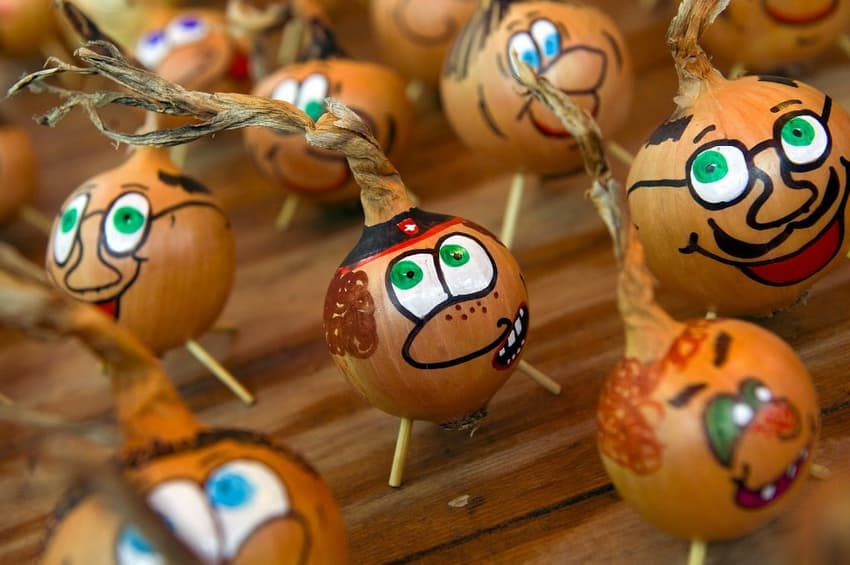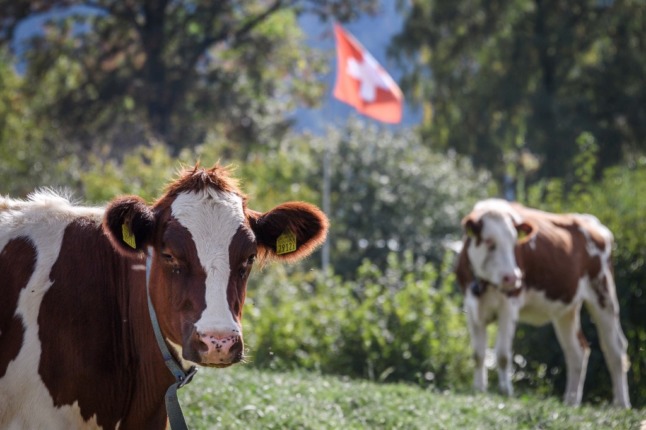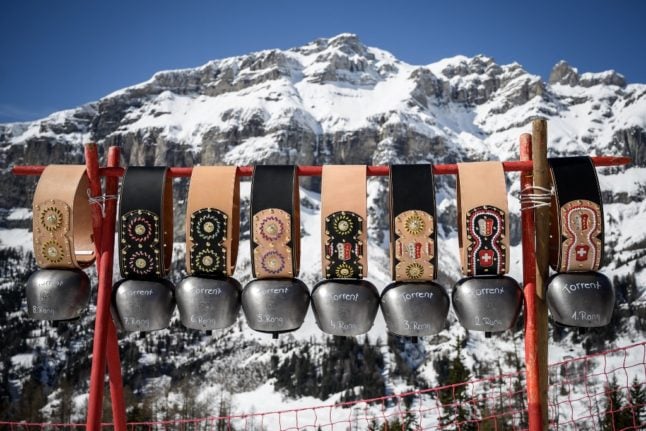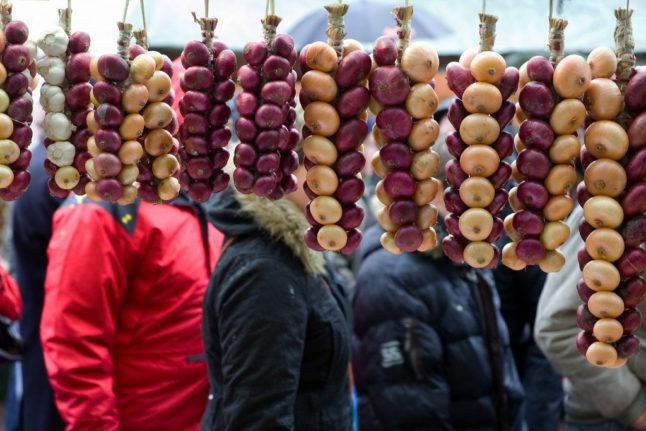8 quirky festivals you should visit to feel really Swiss

Although Switzerland is a small country, its culture is diverse and, at times, surprisingly quirky. Here are five wacky traditions you may not know about but you should definitely check out at least once.
In a previous story, we established that the Swiss do actually have a sense of humour.
And you could argue that this is reflected in some decidedly off-the-wall ways that people across Switzerland celebrate various regional holidays.
These eight from various regions of the country go above and beyond the usual folkloric displays of yodelling, alphorn playing, and flag waving.
Some of them are related to things many of us think of as quintessentially “Swiss” — such as cattle — while others are a bit more bizarre.
Cow fighting, Valais
In a country with a pacifist reputation, the cows can get quite combative.
The Hérens breed of cattle, which are specific to some regions of Valais, are known for their sense of hierarchy and feisty nature.
They take no bull from anyone.
Only one can be crowned as queen, so while the spectators cheer from the stands, the cows literally lock horns in their fight for supremacy within the herd, canton, and even the nation, in what has become an annual event held in the spring in the appropriately named Val d’Hérens.

Cows graze in a field next to a Swiss flag floating in the air, in Brenets, western Switzerland, on September 20, 2018 in Les Brenets. (Photo by Fabrice COFFRINI / AFP)
Knabenschiessen, Zurich
Each September, the sound of gunfire resounds around Switzerland’s largest city.
It is just a bunch of teenagers doing what comes naturally to nearly every Swiss: sharpshooting.
But there’s nothing worrying about it, as the 12- to 16-year-olds are participating in Knabenschiessen (don’t try to pronounce it), the world's largest youth rifle competition.
It is one of the oldest in Switzerland, dating back to the 17th century — well before Switzerland’s other weapon, the army knife, was invented.
While the sight of youngsters walking around with rifles slung across their shoulders may alarm some people, it shouldn’t. This is, after all, Switzerland, where guns are arguably as much a part of culture as cheese, chocolate and…fighting cows.
READ ALSO: Understanding Switzerland's obsession with guns
Pfingstbluttlern, Basel-Country
Scaring your fellow villagers sounds like loads of fun and residents of Ettingen, a community in Basel-Country, have taken this practice to a whole new level.
So much so that Pfingstbluttlern (again, don’t try to pronounce it) is now a local tradition, part of a little-known ancient fertility ritual.
Simply put, during the Pentecost, local men dress up as bushes, parade around town, accost women, and dump them in fountains, all in the name of fun and tradition.
Hey, what’s not to like?
Funkensonntag, Appenzell
If the name of this holiday sounds like “Funky Sunday”, it’s because it is.
What it actually means is “Spark Sunday”, so named after an old custom in which communities around Appenzell competed to see who can produce the greatest spark.
But what is actually funkier (and at least as dangerous) than setting fire to bales of straw is children lighting up cigarettes.
Children are allowed to smoke cigarettes and cigars for the duration of the festival, but need to pack the smokes away when the festival is over.
As you can probably see from the images, they certainly enjoy it.
These days, the Funkensonntag is a cattle festival held in October — the only such event in Switzerland (and possibly elsewhere as well) where children are allowed to smoke.
Nobody actually knows how this custom originated or why it is still allowed, but it is probably one of the weirdest.

Swiss cow bells on display, Photo by Fabrice COFFRINI / AFP)
Eis-Zwei-Geissebei, St. Gallen
Most people in Switzerland eat sausages, not toss them out the window.
Except in Rapperswill, canton St. Gallen, where the sausage-tossing is an actual tradition, believed to date back to the siege and destruction of the town on February 24th,1350.
Heute hiess es wieder "Eins, Zwei, Geissebei..:" in #Rapperswil. Das #bexio Team wünscht allen einen schönen Fastnachts-Dienstag. pic.twitter.com/mSV1Y0UX9c
— bexio (@bexiocom) February 13, 2018
Basically, each year on that day the windows of the town hall open and a council member asks “Sind alli mini Buebe doo?” (Are all my boys here?).
Hundreds of expectant children gather in front of the building shout back “Ja! Eis, zwei, Geissebei!“(Yes, one, two, goat-leg), after which sausages and other foods are tossed out of the window.
Zibelemärit, Bern
As both the capital city of Switzerland and the canton of Bern, the city of Bern sure knows how to impress.
Whether you’re visiting for a stroll through its historic old town (a UNESCO World Heritage Site), fancy seeing the infamous bear pit (Bärengraben), or just want to grimace at the Kindlifresserbrunnen (Child-Eater-Fountain), there are plenty of things to catch your eye in Bern.
But what if we told you onions, of all things, are also a highlight?
Every year on the fourth Monday in November Bern plays host to the country’s only dedicated onion market where Bernese farmers unite to sell their decorative onion creations, such as wreaths, pies, sausages, and even mock bread lookalikes.
The market opens early, at around 3 to 4 am, and you’d be well advised to rise (early) for the occasion as groups of people swarm the Zibelemärit in the late morning, also called the Gstungg.

Visitors stand behind chains of onions during the traditional one-day Zibelemarit (onion market). (Photo by FABRICE COFFRINI / AFP)
Hom Strom, Grisons Scuol
On the first Saturday in February the older children gather at the town square in the lower part of Scuol to build a giant straw man (Hom Strom) by twisting thick strands of rye around a telephone pole almost eight metres (24ft) in length.
The children must finish the effigy by noon from which point it is guarded until 8 pm to protect it from vandalism – rival villages are known to try their hand at destroying the effigy – and then set on fire to welcome spring.
This pagan tradition dates back to ancient fertility festivals and is supposed to ward off evil spirits and chase away winter.
Though this is an event aimed at children, adults are known to help the kids build the effigy each year because let's face it, everyone likes to embrace their inner child.
Absinthe festival, Neuchâtel
The Jura of canton sure knows how to have a good time.
This year, the Absinthe festival takes place on June 10th and allows you to visit several distinguished distilleries of Val-de-Travers, including the Absinthe house ( L'Absinthe House) and the absinthe drying shed at at Boveresse.
You can also chat to growers and other artisans and purchase a range of non-drink absinthe-related products.
Comments
See Also
In a previous story, we established that the Swiss do actually have a sense of humour.
And you could argue that this is reflected in some decidedly off-the-wall ways that people across Switzerland celebrate various regional holidays.
These eight from various regions of the country go above and beyond the usual folkloric displays of yodelling, alphorn playing, and flag waving.
Some of them are related to things many of us think of as quintessentially “Swiss” — such as cattle — while others are a bit more bizarre.
Cow fighting, Valais
In a country with a pacifist reputation, the cows can get quite combative.
The Hérens breed of cattle, which are specific to some regions of Valais, are known for their sense of hierarchy and feisty nature.
They take no bull from anyone.
Only one can be crowned as queen, so while the spectators cheer from the stands, the cows literally lock horns in their fight for supremacy within the herd, canton, and even the nation, in what has become an annual event held in the spring in the appropriately named Val d’Hérens.

Knabenschiessen, Zurich
Each September, the sound of gunfire resounds around Switzerland’s largest city.
It is just a bunch of teenagers doing what comes naturally to nearly every Swiss: sharpshooting.
But there’s nothing worrying about it, as the 12- to 16-year-olds are participating in Knabenschiessen (don’t try to pronounce it), the world's largest youth rifle competition.
It is one of the oldest in Switzerland, dating back to the 17th century — well before Switzerland’s other weapon, the army knife, was invented.
While the sight of youngsters walking around with rifles slung across their shoulders may alarm some people, it shouldn’t. This is, after all, Switzerland, where guns are arguably as much a part of culture as cheese, chocolate and…fighting cows.
READ ALSO: Understanding Switzerland's obsession with guns
Pfingstbluttlern, Basel-Country
Scaring your fellow villagers sounds like loads of fun and residents of Ettingen, a community in Basel-Country, have taken this practice to a whole new level.
So much so that Pfingstbluttlern (again, don’t try to pronounce it) is now a local tradition, part of a little-known ancient fertility ritual.
Simply put, during the Pentecost, local men dress up as bushes, parade around town, accost women, and dump them in fountains, all in the name of fun and tradition.
Hey, what’s not to like?
Funkensonntag, Appenzell
If the name of this holiday sounds like “Funky Sunday”, it’s because it is.
What it actually means is “Spark Sunday”, so named after an old custom in which communities around Appenzell competed to see who can produce the greatest spark.
But what is actually funkier (and at least as dangerous) than setting fire to bales of straw is children lighting up cigarettes.
Children are allowed to smoke cigarettes and cigars for the duration of the festival, but need to pack the smokes away when the festival is over.
As you can probably see from the images, they certainly enjoy it.
These days, the Funkensonntag is a cattle festival held in October — the only such event in Switzerland (and possibly elsewhere as well) where children are allowed to smoke.
Nobody actually knows how this custom originated or why it is still allowed, but it is probably one of the weirdest.

Eis-Zwei-Geissebei, St. Gallen
Most people in Switzerland eat sausages, not toss them out the window.
Except in Rapperswill, canton St. Gallen, where the sausage-tossing is an actual tradition, believed to date back to the siege and destruction of the town on February 24th,1350.
Heute hiess es wieder "Eins, Zwei, Geissebei..:" in #Rapperswil. Das #bexio Team wünscht allen einen schönen Fastnachts-Dienstag. pic.twitter.com/mSV1Y0UX9c
— bexio (@bexiocom) February 13, 2018
Basically, each year on that day the windows of the town hall open and a council member asks “Sind alli mini Buebe doo?” (Are all my boys here?).
Hundreds of expectant children gather in front of the building shout back “Ja! Eis, zwei, Geissebei!“(Yes, one, two, goat-leg), after which sausages and other foods are tossed out of the window.
Zibelemärit, Bern
As both the capital city of Switzerland and the canton of Bern, the city of Bern sure knows how to impress.
Whether you’re visiting for a stroll through its historic old town (a UNESCO World Heritage Site), fancy seeing the infamous bear pit (Bärengraben), or just want to grimace at the Kindlifresserbrunnen (Child-Eater-Fountain), there are plenty of things to catch your eye in Bern.
But what if we told you onions, of all things, are also a highlight?
Every year on the fourth Monday in November Bern plays host to the country’s only dedicated onion market where Bernese farmers unite to sell their decorative onion creations, such as wreaths, pies, sausages, and even mock bread lookalikes.
The market opens early, at around 3 to 4 am, and you’d be well advised to rise (early) for the occasion as groups of people swarm the Zibelemärit in the late morning, also called the Gstungg.

Hom Strom, Grisons Scuol
On the first Saturday in February the older children gather at the town square in the lower part of Scuol to build a giant straw man (Hom Strom) by twisting thick strands of rye around a telephone pole almost eight metres (24ft) in length.
The children must finish the effigy by noon from which point it is guarded until 8 pm to protect it from vandalism – rival villages are known to try their hand at destroying the effigy – and then set on fire to welcome spring.
This pagan tradition dates back to ancient fertility festivals and is supposed to ward off evil spirits and chase away winter.
Though this is an event aimed at children, adults are known to help the kids build the effigy each year because let's face it, everyone likes to embrace their inner child.
Absinthe festival, Neuchâtel
The Jura of canton sure knows how to have a good time.
This year, the Absinthe festival takes place on June 10th and allows you to visit several distinguished distilleries of Val-de-Travers, including the Absinthe house ( L'Absinthe House) and the absinthe drying shed at at Boveresse.
You can also chat to growers and other artisans and purchase a range of non-drink absinthe-related products.
Join the conversation in our comments section below. Share your own views and experience and if you have a question or suggestion for our journalists then email us at [email protected].
Please keep comments civil, constructive and on topic – and make sure to read our terms of use before getting involved.
Please log in here to leave a comment.